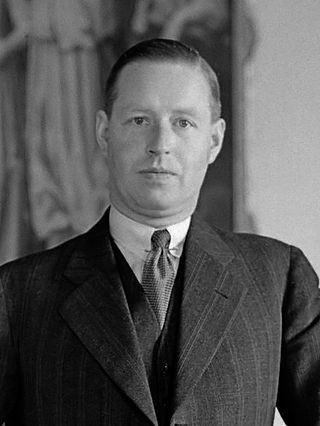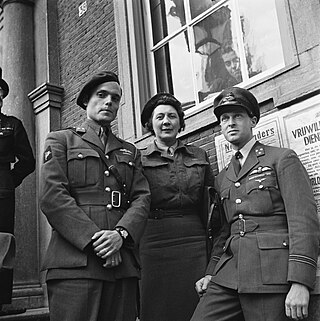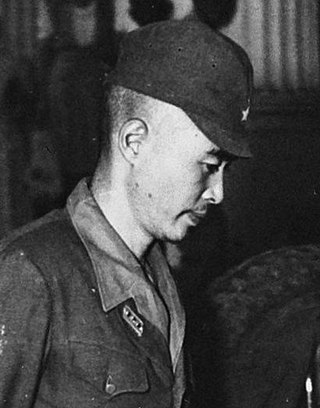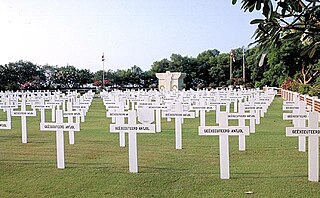
Petrus Jozef Sietse "Piet" de Jong was a Dutch politician and naval officer who served as Prime Minister of the Netherlands from 1967 to 1971. He was a member of the now-defunct Catholic People's Party (KVP), later merged into the current-day Christian Democratic Appeal (CDA).

JonkheerAlidius Warmoldus Lambertus Tjarda van Starkenborgh Stachouwer was a Dutch nobleman and statesman, primarily noted for being the last colonial Governor-General of the Dutch East Indies, now Indonesia. He was taken captive after accepting Japan's demands for an unconditional surrender of the islands on 9 March 1942.

Reinout Willem van Bemmelen, also known as Rein van Bemmelen, was a Dutch geologist whose interests were structural geology, economic geology and volcanology. He is known for his work on these subjects and the geology of Indonesia.
A civilian internee is a civilian detained by a party to a war for security reasons. Internees are usually forced to reside in internment camps. Historical examples include Japanese American internment and internment of German Americans in the United States during World War II. Japan interned 130,000 Dutch, British, and American civilians in Asia during World War II.

Jeroen Godfried Marie Brouwers was a Dutch writer.

Antonia "Tonke" Johanna Dragt was a Dutch writer and illustrator of children's literature. Her book De brief voor de koning was chosen by CPNB as the best Dutch youth book of the latter half of the twentieth century.
Tropic of Emerald or De gordel van smaragd is a 1997 Dutch drama film directed by Orlow Seunke.

The Dutch East Indies, also known as the Netherlands East Indies, was a Dutch colony with territory mostly comprising the modern state of Indonesia, which declared independence on 17 August 1945. Following the Indonesian War of Independence, Indonesia and the Netherlands made peace in 1949. In the Anglo-Dutch Treaty of 1824, the Dutch ceded the governorate of Dutch Malacca to Britain, leading to its eventual incorporation into Malacca (state) of modern Malaysia.

In Dutch historiography, Bersiap refers to the violent and chaotic beginning of the Indonesian National Revolution following the end of World War II in Asia. In Indonesia, the term Berdaulat ("Sovereign") is also used for this transitional period. It began after Sukarno's proclamation of Indonesian Independence on 17 August 1945 and culminated during the power vacuum between the withdrawal of Japanese occupational forces and the gradual buildup of a British military presence, before the official handover to a Dutch military presence in March 1946.

Robert Nieuwenhuys was a Dutch writer of Indo descent. The son of a 'Totok' Dutchman and an Indo-European mother, he and his younger brother Roelof, grew up in Batavia, where his father was the managing director of the renowned Hotel des Indes.

Peter Tazelaar was a member of the Dutch resistance during World War II and worked as an agent for the SOE. Following the war he served in Dutch East Indies, before returning to Europe to work behind the Iron Curtain in Eastern Europe for the United States, which served as an inspiration for Ian Fleming's James Bond series.

The Netherlands Indies Civil Administration was a semi-military organisation, established in April 1944, tasked with the restoration of civil administration and law of Dutch colonial rule after the capitulation of the Japanese occupational forces in the Dutch East Indies at the end of World War II.

The Indo people or Indos are Eurasian people living in or connected with Indonesia. In its narrowest sense, the term refers to people in the former Dutch East Indies who held European legal status but were of mixed Dutch and indigenous Indonesian descent as well as their descendants today.

Lydia Chagoll was a Dutch born dancer, choreographer, film director, screenwriter, writer and actress.

Louis Johan Alexander Schoonheyt (1903-1986), commonly known as L. J. A. Schoonheyt, was a Dutch medical doctor, writer, and supporter of the National Socialist Movement in the Netherlands before World War II. From 1935 to 1936 he was the camp doctor at the Boven-Digoel concentration camp in New Guinea, Dutch East Indies, and is mostly known today for the book he wrote about his experiences there, Boven-Digoel: Het land van communisten en kannibalen (1936). His praise for the conditions in the camp earned him the ire of the internees, Indonesian nationalists, and Dutch human rights advocates; E. du Perron called him a 'colonial bandit', while many internees burned his book after reading it in the camp.

Franciscus Cornelis Gerardus "Fred" van der Poel was a Dutch military officer, and a football goalkeeper. He played one match for the Netherlands national football team in 1923. During World War II, he was taken prisoner of war by Japan and worked on the Burma Railway. He survived and fought in the Indonesian National Revolution on the Dutch side.
The Foundation of Japanese Honorary Debts is an independent interest group in the Netherlands for those who incurred physical, mental and material damages inside and outside Japanese-run internment camps in the course of the Japanese occupation of the Dutch East Indies during World War II.

Kenichi Sone, also rendered as Kenitji Sonei and variants, was an Imperial Japanese Army captain during the Pacific War. Following the Japanese conquest and occupation of the Dutch East Indies, he was the commander of the 10th Battalion prisoner of war camp from September 1942 to February 1944 and of the Tjideng civilian internment camp from April 1944 to June 1945.

Ancol War Cemetery, also Dutch Field of Honor Ancol, is a war cemetery in Ancol, Jakarta, in Indonesia. It is one of two Dutch war cemeteries in Jakarta, the other being Menteng Pulo War Cemetery in Tebet. The cemetery was inaugurated on 14 September 1946. More than 2,000 victims of the Pacific War are buried here, including 1,328 members of the resistance against the Japanese occupation of the Dutch East Indies.






















